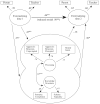Knowledge Structures, Social Information Processing, and Children's Aggressive Behavior
- PMID: 20011226
- PMCID: PMC2792757
- DOI: 10.1111/1467-9507.00092
Knowledge Structures, Social Information Processing, and Children's Aggressive Behavior
Abstract
Although a multitude of factors may be involved in the development of children's violent behavior, the actual aggressive act is preceded by a decision-making process that serves as the proximal control mechanism. The primary goal of this longitudinal study was to understand the nature of this proximal control mechanism involved in children's aggressive acts by focusing on two aspects of social cognitions: social information processing and stored knowledge (i.e., internal knowledge structures that are the latent memories of past events). It was hypothesized that: (1) children with hostile knowledge structures will display more biased patterns of aggressive social information processing than children whose knowledge structures are less hostile and negative; (2) children who display hostile knowledge structures will behave in chronically aggressive ways; and (3) the development of hostile knowledge structures and hostile patterns of social information processing contribute to the stability of aggressive behavior and thus partially mediate the relation between early and later aggressive behavior. 585 boys and girls (19% African-American) were followed from kindergarten through eighth grade. Results from this investigation support the hypotheses and are discussed in terms of the significance of the inclusion of knowledge structures in our theories of the mental processes involved in children's violent behaviour.
Figures
References
-
- Abelson RP. The psychological status of the script concept. American Psychologist. 1981;36:715–729.
-
- Achenbach TM. Manual for the teacher's report form and 1991 profile. Burlington: University of Vermont; 1991.
-
- Achenbach TM. Integrative guide for the 1991 CBCL/4–18, YSR, and TRF profiles. Burlington: University of Vermont, Department of Psychiatry; 1991a.
-
- Achenbach TM. Manual for the Child Behavior Checklist and 1991 Profile. Burlington: University of Vermont, Department of Psychiatry; 1991b.
-
- Akers RL. Deviant behavior: A social learning approach. 3rd. Belmont, CA: Wadsworth; 1985.
Grants and funding
LinkOut - more resources
Full Text Sources
Miscellaneous


